 Despite plans having recently been expanded with international partnerships, including the Russian space program, the International Space Station comes within a single vote of being cancelled altogether in the United States House of Representatives. The measure to cancel the program is added to NASA’s authorization bill, which comes up for an annual vote; the measure is brought to the House floor by Indiana Democratic Rep. Tim Roemer and New Jersey Republican Rep. Richard Zimmer. Opposition to the space station comes in the form of budget concerns (the $9,000,000,000 already run up in research and construction is more than the total NASA expected to spend when it was directed to build, launch, and staff the station during the Reagan administration). Opponents of the station keep up their attempts to cancel it, however; a vote is later held for a bill that would strip NASA of station funding, effectively ending the program, and that vote also fails. The program survives by a wider margin in a later Senate vote as well. The same session of Congress does prove to be the end of another major scientific endeavour, the Superconducting Supercollider project already under construction in Texas.
Despite plans having recently been expanded with international partnerships, including the Russian space program, the International Space Station comes within a single vote of being cancelled altogether in the United States House of Representatives. The measure to cancel the program is added to NASA’s authorization bill, which comes up for an annual vote; the measure is brought to the House floor by Indiana Democratic Rep. Tim Roemer and New Jersey Republican Rep. Richard Zimmer. Opposition to the space station comes in the form of budget concerns (the $9,000,000,000 already run up in research and construction is more than the total NASA expected to spend when it was directed to build, launch, and staff the station during the Reagan administration). Opponents of the station keep up their attempts to cancel it, however; a vote is later held for a bill that would strip NASA of station funding, effectively ending the program, and that vote also fails. The program survives by a wider margin in a later Senate vote as well. The same session of Congress does prove to be the end of another major scientific endeavour, the Superconducting Supercollider project already under construction in Texas.
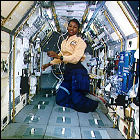 Space Shuttle Endeavour lifts off on the 50th space shuttle mission (and its own first return flight to orbit). Carrying the Spacelab module in its cargo bay, Endeavour hosts the first Japanese shuttle astronaut and the first African-American woman in space. Over eight days, the crew performs various science experiments. Endeavour is flown by Commander Robert “Hoot” Gibson, Pilot Curtis Brown, Payload Commander Mark Lee, missions specialists Jan Davis, Jay Apt and Mae Jemison, and payload specialist Mamoru Mohri.
Space Shuttle Endeavour lifts off on the 50th space shuttle mission (and its own first return flight to orbit). Carrying the Spacelab module in its cargo bay, Endeavour hosts the first Japanese shuttle astronaut and the first African-American woman in space. Over eight days, the crew performs various science experiments. Endeavour is flown by Commander Robert “Hoot” Gibson, Pilot Curtis Brown, Payload Commander Mark Lee, missions specialists Jan Davis, Jay Apt and Mae Jemison, and payload specialist Mamoru Mohri.
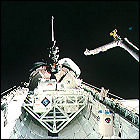 Space Shuttle Columbia lifts off on the shuttle program’s 51st flight, a ten-day mission to launch Laser Geodynamic Satellite II and the cargo-bay-mounted U.S. Microgravity Payload experiment package. Aboard Columbia for her 13th flight are Commander James Wetherbee, Pilot Michael Baker, mission specialists Charles Veach, William Shepherd and Tamara Jernigan, and payload specialist Steven MacLean.
Space Shuttle Columbia lifts off on the shuttle program’s 51st flight, a ten-day mission to launch Laser Geodynamic Satellite II and the cargo-bay-mounted U.S. Microgravity Payload experiment package. Aboard Columbia for her 13th flight are Commander James Wetherbee, Pilot Michael Baker, mission specialists Charles Veach, William Shepherd and Tamara Jernigan, and payload specialist Steven MacLean.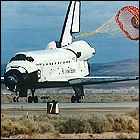 Space Shuttle Discovery lifts off on the 52nd shuttle flight, a seven-day mission to deploy a classified Department of Defense payload and conduct various science experiments within the shuttle itself. Flying Discovery on its 15th launch are Commander David Walker, Pilot Robert Cabana, and mission specialists Guion Bluford, James Voss and Michael Clifford.
Space Shuttle Discovery lifts off on the 52nd shuttle flight, a seven-day mission to deploy a classified Department of Defense payload and conduct various science experiments within the shuttle itself. Flying Discovery on its 15th launch are Commander David Walker, Pilot Robert Cabana, and mission specialists Guion Bluford, James Voss and Michael Clifford. Space Shuttle Endeavour lifts off on the 53rd shuttle flight, a six-day mission to launch the fifth TDRS (Tracking & Data Relay Satellite) and perform assorted experiments. A five-hour spacewalk is conducted in the cargo bay to practice spacewalking techniques for future missions. Aboard Endeavour for her third flight are Commander John Casper, Pilot Donald McMonagle, and mission specialists Mario Runco, Gregory Harbaugh and Susan Helms.
Space Shuttle Endeavour lifts off on the 53rd shuttle flight, a six-day mission to launch the fifth TDRS (Tracking & Data Relay Satellite) and perform assorted experiments. A five-hour spacewalk is conducted in the cargo bay to practice spacewalking techniques for future missions. Aboard Endeavour for her third flight are Commander John Casper, Pilot Donald McMonagle, and mission specialists Mario Runco, Gregory Harbaugh and Susan Helms. Cosmonauts Gennadi Manakov and Alexander Poleshchuk lift off aboard Soyuz TM-16, on a course for Russian space station Mir. In preparation for the upcoming joint international missions that will see American space shuttles docking with Mir, Soyuz TM-16 carries a new type of docking mechanism designed to test the docking port that will be used by visiting shuttles. Manakov and Poleshchuk remain aboard Mir for 179 days, returning to Earth in July 1993 with French spationaut Jean-Pierre Haigneré.
Cosmonauts Gennadi Manakov and Alexander Poleshchuk lift off aboard Soyuz TM-16, on a course for Russian space station Mir. In preparation for the upcoming joint international missions that will see American space shuttles docking with Mir, Soyuz TM-16 carries a new type of docking mechanism designed to test the docking port that will be used by visiting shuttles. Manakov and Poleshchuk remain aboard Mir for 179 days, returning to Earth in July 1993 with French spationaut Jean-Pierre Haigneré.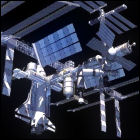 Having drawn the European Space Agency and Japan into partnerships for the still-on-the-drawing-board Space Station Freedom project, NASA announces that it is reaching out to post-Soviet Russia, not just for ideas and engineering expertise, but to become partners in the new space station. With already-built modules sitting on the ground for a Mir 2 station that it cannot afford to launch and operate on its own, Russia becomes a full partner in what will now become the International Space Station. Plans are accelerated for proposed missions to dock the Space Shuttle to the existing Mir space station, and to use Russian Soyuz capsules for crew transfer and return.
Having drawn the European Space Agency and Japan into partnerships for the still-on-the-drawing-board Space Station Freedom project, NASA announces that it is reaching out to post-Soviet Russia, not just for ideas and engineering expertise, but to become partners in the new space station. With already-built modules sitting on the ground for a Mir 2 station that it cannot afford to launch and operate on its own, Russia becomes a full partner in what will now become the International Space Station. Plans are accelerated for proposed missions to dock the Space Shuttle to the existing Mir space station, and to use Russian Soyuz capsules for crew transfer and return.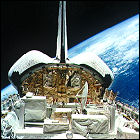 Space Shuttle Discovery lifts off with the ATLAS-2 scientific payload for a nine-day mission. A free-floating platform to measure solar wind activity is also deployed and then retrieved before returning to Earth. Aboard Discovery for her 16th flight are Commander Kenneth Cameron, Pilot Stephen Oswald, and mission specialists Michael Foale, Kenneth Cockrell and Ellen Ochoa.
Space Shuttle Discovery lifts off with the ATLAS-2 scientific payload for a nine-day mission. A free-floating platform to measure solar wind activity is also deployed and then retrieved before returning to Earth. Aboard Discovery for her 16th flight are Commander Kenneth Cameron, Pilot Stephen Oswald, and mission specialists Michael Foale, Kenneth Cockrell and Ellen Ochoa.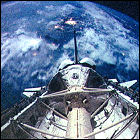 Space Shuttle Columbia lifts off on a mission lasting nearly ten days, carrying the Spacelab laboratory module in its cargo bay. This flight, Spacelab D-2, includes medical and material experiments, with one experiment controlled by an Apple Macintosh computer carried into orbit. Amateur radio messages are exchanged with the crew of the Mir space station. Aboard Columbia for her 14th flight are Commander Steven Nagel, Pilot Terence Henricks, mission specialists Jerry Ross, Charles Precourt and Bernard Harris Jr., and payload specialists Ulrich Walter and Hans Schlegel.
Space Shuttle Columbia lifts off on a mission lasting nearly ten days, carrying the Spacelab laboratory module in its cargo bay. This flight, Spacelab D-2, includes medical and material experiments, with one experiment controlled by an Apple Macintosh computer carried into orbit. Amateur radio messages are exchanged with the crew of the Mir space station. Aboard Columbia for her 14th flight are Commander Steven Nagel, Pilot Terence Henricks, mission specialists Jerry Ross, Charles Precourt and Bernard Harris Jr., and payload specialists Ulrich Walter and Hans Schlegel.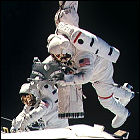 NASA launches Space Shuttle Endeavour on a mission lasting almost ten days to test the SPACEHAB pressurized lab module. A long-term exposure experiment is retrieved for ESA, though a spacewalk must be undertaken when its antennae fail to stow themselves away automatically for insertion into the cargo bay. Aboard Endeavour for her fourth flight into orbit are Commander Ronald Grabe, Pilot Brian Duffy, Payload Commander G. David Low, and mission specialists Nancy Sherlock, Peter Wisoff and Janice Voss.
NASA launches Space Shuttle Endeavour on a mission lasting almost ten days to test the SPACEHAB pressurized lab module. A long-term exposure experiment is retrieved for ESA, though a spacewalk must be undertaken when its antennae fail to stow themselves away automatically for insertion into the cargo bay. Aboard Endeavour for her fourth flight into orbit are Commander Ronald Grabe, Pilot Brian Duffy, Payload Commander G. David Low, and mission specialists Nancy Sherlock, Peter Wisoff and Janice Voss. Despite plans having recently been expanded with international partnerships, including the Russian space program, the International Space Station comes within a single vote of being cancelled altogether in the United States House of Representatives. The measure to cancel the program is added to NASA’s authorization bill, which comes up for an annual vote; the measure is brought to the House floor by Indiana Democratic Rep. Tim Roemer and New Jersey Republican Rep. Richard Zimmer. Opposition to the space station comes in the form of budget concerns (the $9,000,000,000 already run up in research and construction is more than the total NASA expected to spend when it was directed to build, launch, and staff the station during the Reagan administration). Opponents of the station keep up their attempts to cancel it, however; a vote is later held for a bill that would strip NASA of station funding, effectively ending the program, and that vote also fails. The program survives by a wider margin in a later Senate vote as well. The same session of Congress does prove to be the end of another major scientific endeavour, the Superconducting Supercollider project already under construction in Texas.
Despite plans having recently been expanded with international partnerships, including the Russian space program, the International Space Station comes within a single vote of being cancelled altogether in the United States House of Representatives. The measure to cancel the program is added to NASA’s authorization bill, which comes up for an annual vote; the measure is brought to the House floor by Indiana Democratic Rep. Tim Roemer and New Jersey Republican Rep. Richard Zimmer. Opposition to the space station comes in the form of budget concerns (the $9,000,000,000 already run up in research and construction is more than the total NASA expected to spend when it was directed to build, launch, and staff the station during the Reagan administration). Opponents of the station keep up their attempts to cancel it, however; a vote is later held for a bill that would strip NASA of station funding, effectively ending the program, and that vote also fails. The program survives by a wider margin in a later Senate vote as well. The same session of Congress does prove to be the end of another major scientific endeavour, the Superconducting Supercollider project already under construction in Texas.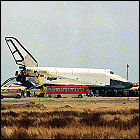 Russian President Boris Yeltsin brings an end to the secretive Soviet-era
Russian President Boris Yeltsin brings an end to the secretive Soviet-era 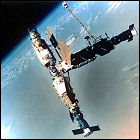 The Russian spacecraft Soyuz TM-17 lifts off from Kazakhstan, bound for space station Mir. Cosmonauts Vasili Tsibliyev, Aleksandr Serebrov replace the incumbent station crew, staying aboard Mir for 196 days, while Jean-Pierre Haigneré returns to Earth with the previous Mir crew aboard Soyuz TM-16 after a three-week stay. When the crew leaves Mir in January 1994, their departure is anything but routine, as Tsibliyev is unable to prevent a collision between Mir and the departing Soyuz.
The Russian spacecraft Soyuz TM-17 lifts off from Kazakhstan, bound for space station Mir. Cosmonauts Vasili Tsibliyev, Aleksandr Serebrov replace the incumbent station crew, staying aboard Mir for 196 days, while Jean-Pierre Haigneré returns to Earth with the previous Mir crew aboard Soyuz TM-16 after a three-week stay. When the crew leaves Mir in January 1994, their departure is anything but routine, as Tsibliyev is unable to prevent a collision between Mir and the departing Soyuz.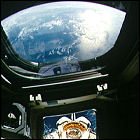 Space Shuttle Discovery lifts off on the 57th shuttle mission, a nine-day stay in orbit to release a communications satellite and test a new second stage engine designed to push that satellite into geosynchronous orbit. A free-floating ultraviolet spectography experiment is released from the shuttle’s cargo bay and retrieved before the end of the mission, and spacewalking techniques for the upcoming Hubble Space Telescope repair mission are practiced. Aboard Discovery for her 17th flight are Commander Frank Culbertson Jr., Pilot William Readdy, and mission specialists James Newman, Daniel Bursch and Carl Walz.
Space Shuttle Discovery lifts off on the 57th shuttle mission, a nine-day stay in orbit to release a communications satellite and test a new second stage engine designed to push that satellite into geosynchronous orbit. A free-floating ultraviolet spectography experiment is released from the shuttle’s cargo bay and retrieved before the end of the mission, and spacewalking techniques for the upcoming Hubble Space Telescope repair mission are practiced. Aboard Discovery for her 17th flight are Commander Frank Culbertson Jr., Pilot William Readdy, and mission specialists James Newman, Daniel Bursch and Carl Walz.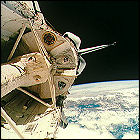 Space Shuttle Columbia is launched on the 58th shuttle mission, a two-week stay in orbit with the Spacelab module. This is the second Spacelab flight devoted to medical experiments and life sciences. Aboard Columbia for her 15th flight are Commander John Blaha, Pilot Richard Searfoss, mission specialists Rhea Seddon, William McArthur, David Wolf and Shannon Lucid, and payload specialist Martin Fettman.
Space Shuttle Columbia is launched on the 58th shuttle mission, a two-week stay in orbit with the Spacelab module. This is the second Spacelab flight devoted to medical experiments and life sciences. Aboard Columbia for her 15th flight are Commander John Blaha, Pilot Richard Searfoss, mission specialists Rhea Seddon, William McArthur, David Wolf and Shannon Lucid, and payload specialist Martin Fettman. NASA launches Space Shuttle Endeavour on a ten-day mission to retrieve and repair the Hubble Space Telescope, which was launched in 1990 with flawed optics. With the $2,000,000,000 telescope held steady in the cargo bay, Endeavour astronauts conduct repairs during spacewalks totaling over 35 hours of the mission, before releasing Hubble back into orbit with new eyes. Aboard Endeavour for her history-making fifth flight are Commander Richard Covey, Pilot Kenneth Bowersox, Payload Commander Story Musgrave, and mission specialists Kathryn Thornton, Claude Nicollier, Jeffrey Hoffman and Tom Akers.
NASA launches Space Shuttle Endeavour on a ten-day mission to retrieve and repair the Hubble Space Telescope, which was launched in 1990 with flawed optics. With the $2,000,000,000 telescope held steady in the cargo bay, Endeavour astronauts conduct repairs during spacewalks totaling over 35 hours of the mission, before releasing Hubble back into orbit with new eyes. Aboard Endeavour for her history-making fifth flight are Commander Richard Covey, Pilot Kenneth Bowersox, Payload Commander Story Musgrave, and mission specialists Kathryn Thornton, Claude Nicollier, Jeffrey Hoffman and Tom Akers.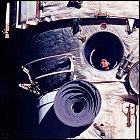 Russian spacecraft Soyuz TM-18 lifts off from Baikonur Cosmodrome in Kazakhstan, on a mission to the Russian space station Mir. Aboard the Soyuz are cosmonauts Viktor Afanasyev, Yuri Usachov, and Dr. Valeri Polyakov, a medical doctor who will study the effects of long-duration spaceflight on the crew (including himself). Following a scary close call with the previous crew’s wayward Soyuz, the TM-18 crew settles in for a 182-day stay, with Afanasyev and Usachov returning to Earth; Polyakov remains aboard Mir, where he will eventually set the human space endurance record with a 420-day stay in orbit.
Russian spacecraft Soyuz TM-18 lifts off from Baikonur Cosmodrome in Kazakhstan, on a mission to the Russian space station Mir. Aboard the Soyuz are cosmonauts Viktor Afanasyev, Yuri Usachov, and Dr. Valeri Polyakov, a medical doctor who will study the effects of long-duration spaceflight on the crew (including himself). Following a scary close call with the previous crew’s wayward Soyuz, the TM-18 crew settles in for a 182-day stay, with Afanasyev and Usachov returning to Earth; Polyakov remains aboard Mir, where he will eventually set the human space endurance record with a 420-day stay in orbit.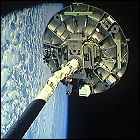 Space Shuttle Discovery lifts off on the 60th flight of the shuttle program. During its eight days in orbit, Discovery hosts the first Russian cosmonaut ever to fly aboard an American spacecraft, initiating an ongoing agreement between the two countries’ space agencies that will eventually lead to shuttles visiting Mir and the construction of the International Space Station. Aboard Discovery for her 18th flight are Commander Charles Bolden, Pilot Kenneth Reightler, and mission specialists Jan Davis, Ronald Sega, Franklin Chang-Diaz and Sergei Krikalev.
Space Shuttle Discovery lifts off on the 60th flight of the shuttle program. During its eight days in orbit, Discovery hosts the first Russian cosmonaut ever to fly aboard an American spacecraft, initiating an ongoing agreement between the two countries’ space agencies that will eventually lead to shuttles visiting Mir and the construction of the International Space Station. Aboard Discovery for her 18th flight are Commander Charles Bolden, Pilot Kenneth Reightler, and mission specialists Jan Davis, Ronald Sega, Franklin Chang-Diaz and Sergei Krikalev. Space Shuttle Columbia lifts off on the 61st shuttle mission, a two-week visit to Earth orbit carrying two cargo-bay-mounted experiment systems operated primarily from the ground. Crew members participate in experiments involving the side-effects of long-term space travel. The crew for Columbia’s 16th flight consists of Commander John Casper, Pilot Andrew Allen, and mission specialists Pierre Thuot, Charles Gemar and Marsha Ivins.
Space Shuttle Columbia lifts off on the 61st shuttle mission, a two-week visit to Earth orbit carrying two cargo-bay-mounted experiment systems operated primarily from the ground. Crew members participate in experiments involving the side-effects of long-term space travel. The crew for Columbia’s 16th flight consists of Commander John Casper, Pilot Andrew Allen, and mission specialists Pierre Thuot, Charles Gemar and Marsha Ivins.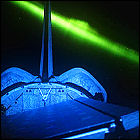 NASA launches Space Shuttle Endeavour on an 11-day mission to carry the Space Radar Laboratory experiment into orbit. The radar systems map sites on Earth and test other applications for orbital radar. Aboard Endeavour for her sixth flight are Commander Sidney Gutierrez, Pilot Kevin Chilton, Payload Commander Linda Godwin, and mission specialists Jay Apt, Michael Clifford and Thomas Jones.
NASA launches Space Shuttle Endeavour on an 11-day mission to carry the Space Radar Laboratory experiment into orbit. The radar systems map sites on Earth and test other applications for orbital radar. Aboard Endeavour for her sixth flight are Commander Sidney Gutierrez, Pilot Kevin Chilton, Payload Commander Linda Godwin, and mission specialists Jay Apt, Michael Clifford and Thomas Jones. Soyuz TM-19 lifts off from Kazakhstan, on a mission to the Russian space station Mir with cosmonauts Yuri Malenchenko and Talgat Musabayev aboard. Over the course of their 125-day stay, the crew joins Dr. Valery Polyakov aboard Mir, in the middle of his record-shattering 437-day stay in space. Malenchenko and Musabayev conduct 11 hours worth of spacewalks to repair Mir’s exterior insulation and other minor maintenance, and returns home in November 1994 with German astronaut Ulf Merbold.
Soyuz TM-19 lifts off from Kazakhstan, on a mission to the Russian space station Mir with cosmonauts Yuri Malenchenko and Talgat Musabayev aboard. Over the course of their 125-day stay, the crew joins Dr. Valery Polyakov aboard Mir, in the middle of his record-shattering 437-day stay in space. Malenchenko and Musabayev conduct 11 hours worth of spacewalks to repair Mir’s exterior insulation and other minor maintenance, and returns home in November 1994 with German astronaut Ulf Merbold. Forge Books posthumously publishes astronaut Deke Slayton’s non-fictional memoir of his time in NASA,
Forge Books posthumously publishes astronaut Deke Slayton’s non-fictional memoir of his time in NASA, 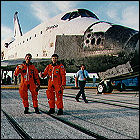 Space Shuttle Columbia is launched on the 63rd mission of the shuttle program. For two weeks, Columbia’s crew participates in the second IML (International Microgravity Laboratory) flight, conducting experiments relying on zero G around the clock. Columbia is also in orbit during the 25th anniversary of Apollo 11, the moon landing mission whose command/service module was also named Columbia. Aboard for Columbia’s 17th flight are Commander Robert Cabana, Pilot James Halsell, Payload Commander Richard Hieb, mission specialists Carl Walz, Leroy Chiao and Donald Thomas, and payload specialist Chiaki Naito-Mukai, the first Japanese woman in space.
Space Shuttle Columbia is launched on the 63rd mission of the shuttle program. For two weeks, Columbia’s crew participates in the second IML (International Microgravity Laboratory) flight, conducting experiments relying on zero G around the clock. Columbia is also in orbit during the 25th anniversary of Apollo 11, the moon landing mission whose command/service module was also named Columbia. Aboard for Columbia’s 17th flight are Commander Robert Cabana, Pilot James Halsell, Payload Commander Richard Hieb, mission specialists Carl Walz, Leroy Chiao and Donald Thomas, and payload specialist Chiaki Naito-Mukai, the first Japanese woman in space.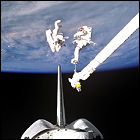 NASA launches Space Shuttle Discovery on the 64th flight of the shuttle program. The cargo bay carries an experiment to test LIDAR applications from orbit, and is the site of a six-hour spacewalk to test an alternative to the retired MMU “jet pack” for EVA rescue purposes. Aboard Discovery for her 19th mission are Commander Richard Richards, Pilot Blaine Hammond, and mission specialists Jerry Linenger, Susan Helms, Carl Meade and Mark Lee.
NASA launches Space Shuttle Discovery on the 64th flight of the shuttle program. The cargo bay carries an experiment to test LIDAR applications from orbit, and is the site of a six-hour spacewalk to test an alternative to the retired MMU “jet pack” for EVA rescue purposes. Aboard Discovery for her 19th mission are Commander Richard Richards, Pilot Blaine Hammond, and mission specialists Jerry Linenger, Susan Helms, Carl Meade and Mark Lee.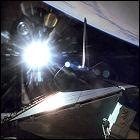 Space Shuttle Endeavour lifts off on the shuttle program’s 65th mission. The eleven-day flight is a second round of space radar experiments, using a cargo-bay-mounted radar system that flew earlier in 1994 aboard Endeavour. The crew for this flight consists of Commander Michael Baker, Pilot Terrence Wilcutt, Payload Commander Thomas Jones, and mission specialists Steven Smith, Daniel Bursch and Peter Wisoff.
Space Shuttle Endeavour lifts off on the shuttle program’s 65th mission. The eleven-day flight is a second round of space radar experiments, using a cargo-bay-mounted radar system that flew earlier in 1994 aboard Endeavour. The crew for this flight consists of Commander Michael Baker, Pilot Terrence Wilcutt, Payload Commander Thomas Jones, and mission specialists Steven Smith, Daniel Bursch and Peter Wisoff.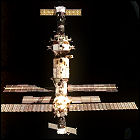 Russia launches the Soyuz TM-20 mission to space station Mir, carrying cosmonauts Alexander Viktorenko and Yelena Kondakova, and German astronaut Ulf Merbold, who will remain for only a month to conduct experiments in orbit. A glitch in the automated docking system forces Viktorenko to assume manual control for the docking with Mir, a problem which will plague future Mir crews. Viktorenko and Kondakova remain aboard Mir for 169 days, returning to Earth in March 1995 with the new space endurance world record holder, Dr. Valery Polyakov, who has spent 437 days in orbit.
Russia launches the Soyuz TM-20 mission to space station Mir, carrying cosmonauts Alexander Viktorenko and Yelena Kondakova, and German astronaut Ulf Merbold, who will remain for only a month to conduct experiments in orbit. A glitch in the automated docking system forces Viktorenko to assume manual control for the docking with Mir, a problem which will plague future Mir crews. Viktorenko and Kondakova remain aboard Mir for 169 days, returning to Earth in March 1995 with the new space endurance world record holder, Dr. Valery Polyakov, who has spent 437 days in orbit.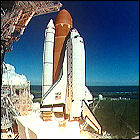 Space Shuttle Atlantis lifts off on its first flight in two years, an 11-day mission to conduct studies of Earth’s atmosphere with the ATLAS package mounted in the cargo bay. Aboard Atlantis for her 13th flight are Commander Donald McMonagle, Pilot Curtis Brown, Payload Commander Ellen Ochoa, and mission specialists Scott Parazynski, Joseph Tanner and Jean-Francois Clervoy.
Space Shuttle Atlantis lifts off on its first flight in two years, an 11-day mission to conduct studies of Earth’s atmosphere with the ATLAS package mounted in the cargo bay. Aboard Atlantis for her 13th flight are Commander Donald McMonagle, Pilot Curtis Brown, Payload Commander Ellen Ochoa, and mission specialists Scott Parazynski, Joseph Tanner and Jean-Francois Clervoy. Space Shuttle Discovery lifts off on the 67th flight of the shuttle program, a history-making mission that sees Discovery conducting rendezvous maneuvers at the Russian space station Mir. Though the shuttle isn’t equipped to dock at Mir, the close flyby is a necessary step before a docking mission can take place, and Discovery’s crew includes a former Mir cosmonaut. The crew for this flight is Commander James Wetherbee, Pilot Eileen M. Collins, and mission Specialists Michael Foale, Janice Voss, Bernard Harris and Vladimar Titov.
Space Shuttle Discovery lifts off on the 67th flight of the shuttle program, a history-making mission that sees Discovery conducting rendezvous maneuvers at the Russian space station Mir. Though the shuttle isn’t equipped to dock at Mir, the close flyby is a necessary step before a docking mission can take place, and Discovery’s crew includes a former Mir cosmonaut. The crew for this flight is Commander James Wetherbee, Pilot Eileen M. Collins, and mission Specialists Michael Foale, Janice Voss, Bernard Harris and Vladimar Titov.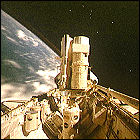 NASA launches Space Shuttle Endeavour on the longest flight of the shuttle program to date – over 16 and a half days – with the ASTRO astronomy experiment package mounted in the cargo bay. Some astronomical observations on this mission are conducted in tandem with the Hubble Space Telescope. Aboard Endeavour for her eighth flight are Commander Stephen Oswald, Pilot William Gregory, Payload Commander Tammy Jernigan, mission specialists John Grunsfeld and Wendy Lawrence, and payload specialists Ronald Parise and Samuel Durrance.
NASA launches Space Shuttle Endeavour on the longest flight of the shuttle program to date – over 16 and a half days – with the ASTRO astronomy experiment package mounted in the cargo bay. Some astronomical observations on this mission are conducted in tandem with the Hubble Space Telescope. Aboard Endeavour for her eighth flight are Commander Stephen Oswald, Pilot William Gregory, Payload Commander Tammy Jernigan, mission specialists John Grunsfeld and Wendy Lawrence, and payload specialists Ronald Parise and Samuel Durrance.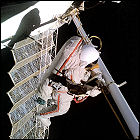 An American astronaut lifts off aboard a Russian Soyuz spacecraft for the first time ever with the launch of Soyuz TM-21, a mission to the Mir space station. Cosmonauts Vladimir Dezhurov and Gennady Strekalov are joined by astronaut Norman Thagard aboard Mir, where they remain for 115 days. During that time, they witness the arrival of the Spektr module, a new addition to the station, and they ultimately return to Earth aboard space shuttle Atlantis in July 1995; Soyuz TM-21 remains at the station, where a future Mir crew uses it to return to Earth. During the Atlantis mission, a new record is set for the number of humans in space, as the station and shuttle crews add up to 13 people in orbit at once.
An American astronaut lifts off aboard a Russian Soyuz spacecraft for the first time ever with the launch of Soyuz TM-21, a mission to the Mir space station. Cosmonauts Vladimir Dezhurov and Gennady Strekalov are joined by astronaut Norman Thagard aboard Mir, where they remain for 115 days. During that time, they witness the arrival of the Spektr module, a new addition to the station, and they ultimately return to Earth aboard space shuttle Atlantis in July 1995; Soyuz TM-21 remains at the station, where a future Mir crew uses it to return to Earth. During the Atlantis mission, a new record is set for the number of humans in space, as the station and shuttle crews add up to 13 people in orbit at once.